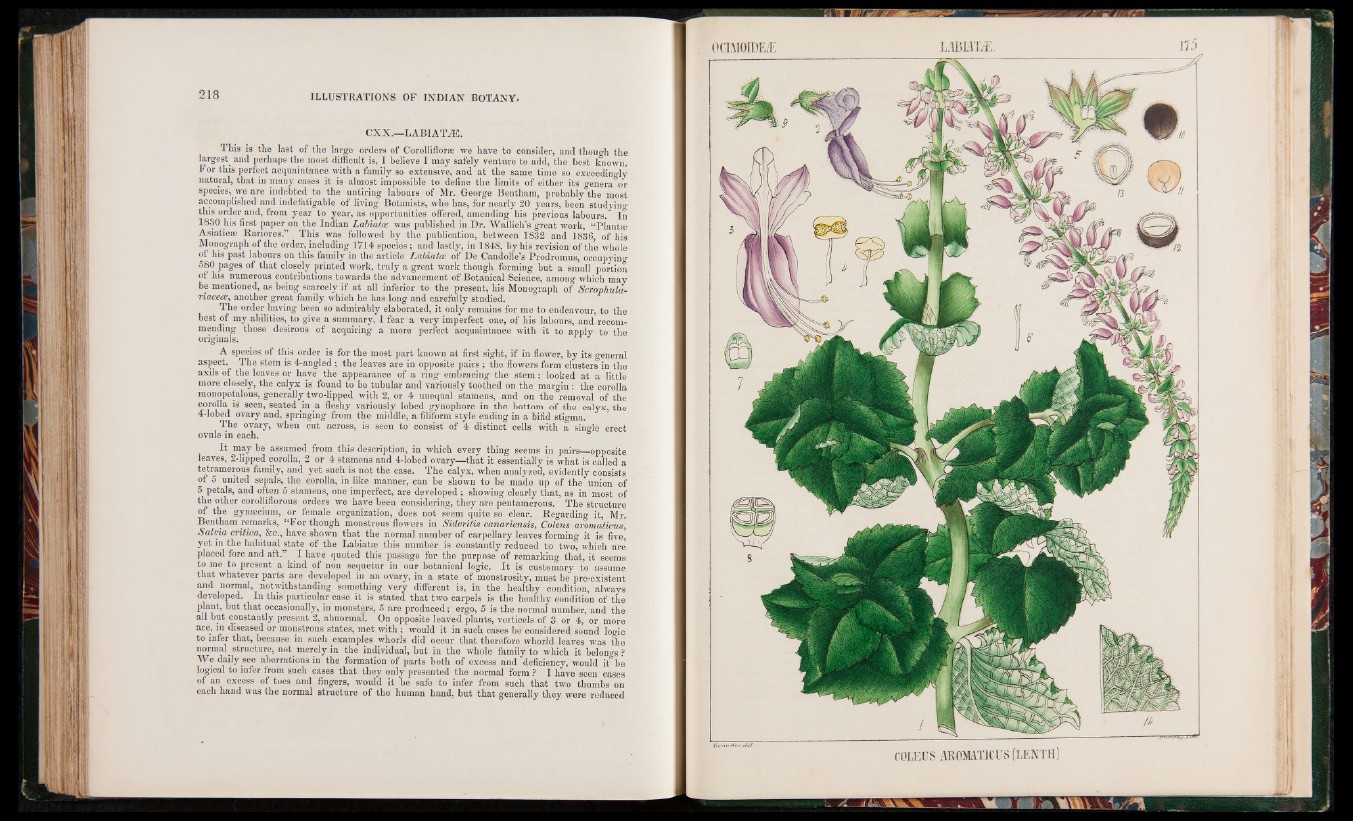
CXX.—LABIATA2.
This is the last of the large orders of Corolliflorse we have to consider, and though the
largest and perhaps the most difficult is, I believe I may safely venture to add, the best known.
For this perfect acquaintance with a family so extensive, and at the same time so exceedingly
natural, that in many cases it is almost impossible to define the limits of either its genera or
species, we are indebted to the untiring labours of Mr. George Bentham, probably the most
accomplished and indefatigable of living Botanists, who has, for nearly 20 years, been studying
this order and, from year to year, as opportunities offered, amending his previous labours. In
1830 his first paper on the Indian Labiatce was published in Dr. Wallich’s great work, “Plantte
Asiatiese Rariores.” This was followed by the publication, between 1832 and 1836, of his
Monograph of the order, including 1714 species ; and lastly, in 1848, by his revision of the whole
of his past labours on this family in the article Labiatce of De Candolle’s Prodromus, occupying
580 pages of that closely printed work, truly a great work though forming but a small portion
of his numerous contributions towards the advancement of Botanical Science, among which may
be mentioned, as being scarcely if at all inferior to the present, his Monograph of Scrophula-
riacece, another great family which he has long and carefully studied.
The order having been so admirably elaborated, it only remains for me to endeavour, to the
best of my abilities, to give a summary, I fear a very imperfect one, of his labours, and recommending
those desirous of acquiring a more perfect acquaintance with it to apply to the
originals. J
A species of this order is for the most part known at first sight, if in flower, by its general
aspect. The stem is 4-angled ; the leaves are in opposite pairs ; the flowers form clusters in the
axils of the leaves or have the appearance of a ring embracing the stem; looked at a little
more closely, the calyx is found to be tubular and variously toothed on the margin : the corolla
monopetalous, generally two-lipped with 2, or 4 unequal stamens, and on the removal of the
corolla is seen, seated in a fleshy variously lobed gynophore in the bottom of the calyx, the
4'-lobed ovary and, springing from the middle, a filiform style ending in a bifid stigma.
The ovary, when cut across, is seen to consist of 4 distinct cells with a single erect
ovule in each.
I t may be assumed from this description, in which every thing seems in pairs__opposite
leaves, 2-lipped corolla, 2 or 4 stamens and 4-lobed ovary—that it essentially is what is called a
tetramerous family, and yet such is not the case. The calyx, when analyzed, evidently consists
of 5 united sepals, the corolla, in like manner, can be shown to be made up of the union of
5 petals, and often 5 stamens, one imperfect, are developed ; showing clearly that, as in most of
the other corolliflorous orders we have been considering, they are pentamerous. The structure
of the gynaecium, or female organization, does not seem quite so clear. Regarding it, Mr.
Bentham remarks, “For though monstrous flowers in Sideritis canariensis, Coleus aromaticus,
Salvia critica, &c., have shown that the normal number of carpellary leaves forming it is five]
yet in the habitual state of the Labiatae this number is constantly reduced to two, which are
placed fore and aft.” 11 have quoted this passage for the purpose of remarking that, it seems
to me to present a kind of non sequetur in our botanical logic. I t is customary to assume
that whatever parts are developed in an ovary, in a state of monstrosity, must be pre-existent
and normal, notwithstanding something very different is, in the healthy condition, always
developed. In this particular case it is stated that two carpels is the healthy condition of the
plant, but that occasionally, in monsters, 5 are produced; ergo, 5 is the normal number, and the
all but constantly present 2, abnormal. On opposite leaved plants, verticels of 3 or 4, or more
are, in diseased or monstrous states, met with; would it in such cases be considered sound logic
to infer that, because in such examples whorls did occur that therefore whorld leaves was the
normal structure, not merely in the individual, but in the whole family to which it belongs?
AVe daily see aberrations in the formation of parts both of excess and deficiency, would it be
logical to infer from such cases that they only presented the normal form ? I have seen cases
of an excess of toes and fingers, would it be safe to infer from such that two thumbs on
each hand was the normal structure of the human hand, but that generally they were reduced
0 C L M 0 1 D E Æ m i m
COLEUS AROMATIC US LENTH
L JL É.&M 5*?